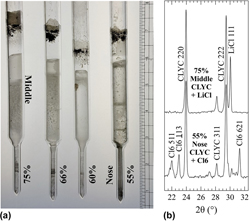Cover: SEM micrographs of failure samples in impact condition. [Z. Zhou, L. Duan, F. Wu: Investigation of Charpy impact behavior of porous twisted wire material. p. 2276].
Invited Paper
Toward high volume solution based roll-to-roll processing of OLEDs
-
- Published online by Cambridge University Press:
- 05 June 2017, pp. 2219-2229
-
- Article
-
- You have access
- Open access
- HTML
- Export citation
Articles
A new approach of the Oliver and Pharr model to fit the unloading curve from instrumented indentation testing
-
- Published online by Cambridge University Press:
- 17 April 2017, pp. 2230-2240
-
- Article
- Export citation
Characterization and investigation of size effect in nano-impact indentations performed using cube-corner indenter tip
-
- Published online by Cambridge University Press:
- 22 May 2017, pp. 2241-2248
-
- Article
- Export citation
Development and properties evaluation of Mg–6% Zn/Al multilayered composites processed by accumulative roll bonding
-
- Published online by Cambridge University Press:
- 18 May 2017, pp. 2249-2257
-
- Article
- Export citation
Drop-weight impact test on an integrated composite sandwich panel of aluminum honeycomb and epoxy resin
-
- Published online by Cambridge University Press:
- 22 May 2017, pp. 2258-2265
-
- Article
- Export citation
Quasi-continuum study of the buckling behavior of single-walled carbon nanocones subjected to bending under thermal loading
-
- Published online by Cambridge University Press:
- 22 May 2017, pp. 2266-2275
-
- Article
- Export citation
Investigation of Charpy impact behavior of porous twisted wire material
-
- Published online by Cambridge University Press:
- 29 May 2017, pp. 2276-2285
-
- Article
- Export citation
Theoretical and experimental analysis of indentation relaxation test
-
- Published online by Cambridge University Press:
- 09 June 2017, pp. 2286-2296
-
- Article
- Export citation
Processing optimization and comprehensive performance on resistance plug welding of dissimilar steel joints
-
- Published online by Cambridge University Press:
- 13 June 2017, pp. 2297-2306
-
- Article
- Export citation
Effect of precipitates on grain growth in non-oriented silicon steel
-
- Published online by Cambridge University Press:
- 24 April 2017, pp. 2307-2314
-
- Article
- Export citation
Microstructures and mechanical properties of as-ECAPed Mg–8Sn alloys with the combined addition of Zn and Al
-
- Published online by Cambridge University Press:
- 18 April 2017, pp. 2315-2324
-
- Article
- Export citation
Interactive formation of Cu-rich precipitate, reverted austenite, and alloyed carbide during partial austenite reversion treatment for high-strength low-alloy steel
-
- Published online by Cambridge University Press:
- 02 May 2017, pp. 2325-2334
-
- Article
- Export citation
Inhibition effect of longitudinal alternating current during annealing on growth of interfacial layers of copper cladding aluminum composite
-
- Published online by Cambridge University Press:
- 22 May 2017, pp. 2335-2342
-
- Article
- Export citation
The inverse parameter identification of Hill’48 yield function for small-sized tube combining response surface methodology and three-point bending
-
- Published online by Cambridge University Press:
- 21 March 2017, pp. 2343-2351
-
- Article
- Export citation
Fabrication of TiB2/Al composite by melt-SHS process with different content of titanium powder
-
- Published online by Cambridge University Press:
- 23 May 2017, pp. 2352-2360
-
- Article
- Export citation
Mechanical and tribological properties of NiAl–NbC–Ag composites prepared by hot-pressing sintering
-
- Published online by Cambridge University Press:
- 22 May 2017, pp. 2361-2372
-
- Article
- Export citation
Understanding phase equilibria and segregation in Bridgman growth of Cs2LiYCl6 scintillator
-
- Published online by Cambridge University Press:
- 22 May 2017, pp. 2373-2380
-
- Article
- Export citation
Investigation of erosion properties of directionally solidified Fe–B alloy in various velocities liquid zinc
-
- Published online by Cambridge University Press:
- 24 April 2017, pp. 2381-2388
-
- Article
- Export citation
Investigation of recrystallization behavior of large sized Nb–V microalloyed steel rod during thermomechanical controlled processing
-
- Published online by Cambridge University Press:
- 08 May 2017, pp. 2389-2396
-
- Article
- Export citation
Physical properties and lattice dynamics of bixbyite-type V2O3
-
- Published online by Cambridge University Press:
- 15 May 2017, pp. 2397-2404
-
- Article
- Export citation






















